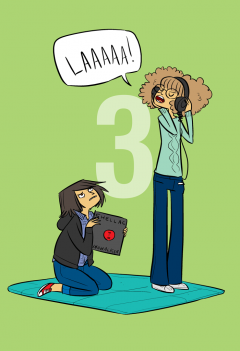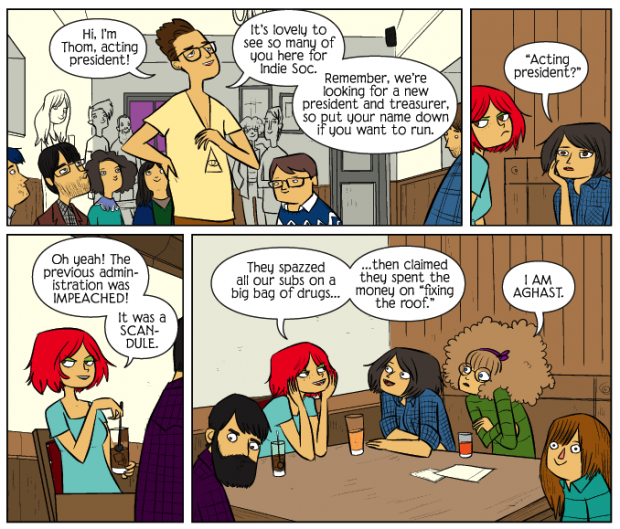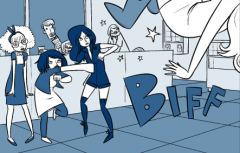“I tried to write something that felt emotionally real, even if the events weren’t particularly grounded.” John Allison’s Giant Days, student societies and digital comics
 John Allison’s Giant Days is the tale of 3 misfit female students and was originally conceived as a plan b in case his main book, Bad Machinery, didn’t work out. However now on it’s 3rd issue it has become a superb comic slice of life that will resonate with anyone who misses those heady days of youthful exuberance from their student days, as well as those are really glad they’ve put those socially awkward years behind them. We offer to buy John a pint from the student union bar before we head down to the indie disco.
John Allison’s Giant Days is the tale of 3 misfit female students and was originally conceived as a plan b in case his main book, Bad Machinery, didn’t work out. However now on it’s 3rd issue it has become a superb comic slice of life that will resonate with anyone who misses those heady days of youthful exuberance from their student days, as well as those are really glad they’ve put those socially awkward years behind them. We offer to buy John a pint from the student union bar before we head down to the indie disco.

Giant Days #3 is released on ComiXology this week, you said in issue #1 you conceived it as a back up plan in case your main book Bad Machinery didn’t work out, do you still feel like that about Giant Days or is it becoming it’s own thing now?
JA: My confidence wasn’t sky high when I started Bad Machinery. I really felt like I’d hit the peak of my popularity three years earlier and couldn’t give people any more of what they wanted. I just wasn’t the same person who’d made those comics. Initially, Giant Days was a back-up plan, but not a replacement – it was just another attempt to see if I could make something that people liked. I started a second issue soon after I finished the first, but didn’t really know where to go with it. A year or so later, I picked up the five pages I’d made and saw where to go next. The second issue suggested a third so I just kept going. I was tempted to run on to a fourth but in the intervening years, Bad Machinery had picked up steam and I wanted to pick up those threads.
The last two books have been released in much less time than previous issues, any plans to develop this into your main book? Or is Bad Machinery still your priority?
JA: Most people who make webcomics make one thing and just soldier on with it non-stop. The more I’ve dabbled with side-projects, the more I appreciate them as palette cleansers that let you use ideas that wouldn’t fit elsewhere. There would be more Giant Days if I wasn’t the artist on it. I can’t do much more than one page a day and that limits my output. But since I did Giant Days, I’ve had ideas for lots of other things too.
JA: I just took a popular character from Scary Go Round, my old series, and built a cast around her. I figured that most floors in halls of residence are single-sex, and she made friends with her next door neighbours, so it was an all-girl cast. When I was at university, people moved in little unisex squads like that.
Do you find it easier to write female characters than males and do you ever second guess your characters motivations? Do you have a ‘gender editor’ to keep you in line?
JA: This will sound awful, I but I don’t think about it at all. You could gender-swap the characters and I think the stories would still work. I just feel my way through stuff. I’m sure all my prejudices are on the page but there’s not a lot I can do about it.
Although the girls occupy the stereotypes of ‘head girl’ ‘outsider’ and ‘nerd’ you give each one very distinct personalities and make them much more than just those cliches, was that an important part of developing the characters or did the stories just evolve around them?
JA: It’s hard to think back four years to when I wrote the first book! I find that characters just develop naturally, the more space you give them. I thought about people I half-knew at university and the two or three facts I might have known about them, and built outward from there. The plots then suggest new ways to go. I try to keep my eyes and ears open, and there’s always new things to add if you pay attention to life.

In the current issues the girls get caught up in Indie Soc and also have dabblings with the Black Metal Society, was that based on your own experience of societies at uni, or did you steer clear of such groups?
JA: My girlfriend was in Indie Soc. She reeled off everything she could remember, I wrote it down, and used that as a starting point. I had no experience of societies, the only society I was in was the Journalism society, and I don’t remember ever attending a meet-up. I was music editor of the university’s online magazine, but that was just a chance to get free records and pretend I worked for a real music mag. I met a lot of people at university but it was only ever by freak accident that they happened to be like minded.
How much of the story as a whole is based on your own uni life and/or that of friends? Do you think that familiarity with uni life is what helps it resonate with people?
JA: I hope that Giant Days resonates! I tried to write something that felt emotionally real, even if the event in it weren’t particularly grounded. I went to university nearly 20 years ago so I can only hope to make that part of it relatable.

The first issue had a real Scott Pilgrim vibe to it (especially the night club punch up scene) what are your influences as a writer and artist? And which comics and web comics do you currently rate and recommend?
JA: I have so many influences at this point that listing them is hard. At the moment I really enjoy Brandon Graham’s work, and Luke Pearson, and Michael DeForge. I’m a huge fan of Eleanor Davis and Jose Luis Agreda’s illustration – such control of form, such design! When I was younger, I’d see something I loved and really try to absorb it into my work. There’s less of the shock of the new now, and I find myself trying to refine what I’m doing instead. But you do need to be a vampire your whole career, I’m sure that soon I’ll head out in search of fresh blood.
JA: ComiXology is something that’s very new to me. I don’t read many comics digitally – I stare at a screen all day and I’m desperate to escape it by the end of the day. I don’t have an iPad. But I think it’s prudent to give people work through the channels they want to use, and ComiXology is a platform that pays the creators, helps readers find new work, and makes good use of the available technology. Through Submit, it’s open to anyone. I don’t think that can be bad.
JA: The current Bad Machinery story only has a couple of weeks left to run, after that I have a two-part story in the traditional US comic book format, set in the mid-nineties. And after that, who knows! I still want to do more Giant Days. We’ll see.
Purchase Giant Days #1-3 for £1.99/$2.99 per issue from ComiXology or you can read Bad Machinery via John’s website scarygoround.com. You can also follow him on twitter @badmachinery



August 19, 2014 @ 3:18 am
It’s interesting and surprising to hear John say that he thinks his characters could be gender swapped without much difference. One of the things I enjoy most about his work is that the female characters feel very developed and realized (the personalities of the Bad Machinery girls in particular), which is uncommon when written by men. I could just be generalizing though.
I was one of those big Esther fans from the Scary Go Round days, and was delighted to see her return for a couple of short stories in Giant Days.
I’m looking forward to what’s coming up next!
August 19, 2014 @ 7:28 am
We were surprised by that comment too. The girls are so brilliantly realised that you can’t imagine them in the opposite genders. It would lose a lot of the charm and subtlety – plus the awesome Ed Gemmell wouldn’t be quite so tragic if he was a girl!